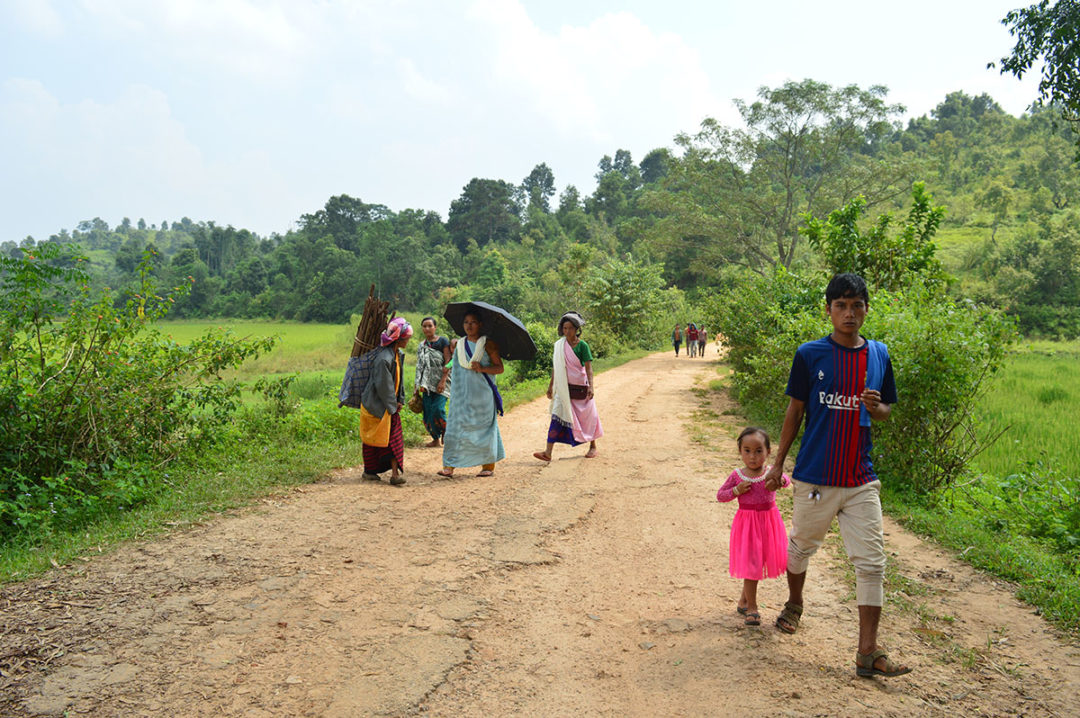No Straitjacket Solution to The Assam-Meghalaya Border Disputes

All governments, in the past and present had made sincere efforts to resolve the one hundred forty-eight years old border imbroglio and the future generations must not be over burden by this. But why is the MDA Government so secretive on the Reports of the Regional Committees and the Memorandum of Understanding (MOU) on borders with Assam? It also fantasizes that it is “the only Government” which is serious about it and none others. This is a dangerous practice in democracy. Although, this Government had convened sporadic meetings with selected non-governmental groups, but it was learnt that they were only given verbal updates and no written reports whatsoever were shared in those meetings. The Reports and especially the MOU which was the final outcome of the various exercises should have been put in public domain soliciting discussions and debated in the State Assembly before inking the MOU in Delhi.
The Constitutional Boundary of Meghalaya is defined in section 5 of the North Eastern Areas (Reorganization) Act 1971. It can be read with section 3 of the Assam Reorganization (Meghalaya) Act 1969 and para 20 of the Sixth Schedule. The boundary of Assam and Meghalaya runs to a total length of 885 Kms. Thus, along this length and in locations like the Block I and II, Basistha-Khanapara, Jirang, Nongwah, Langpih sectors etc in Khasi and Jaiῆtia Hills and in eighteen pockets in Toporpara, Hallidagganj, Boglarbheta-Kalapara, Rongsai-Pesaldoba areas etc in Garo Hills District that tensions frequently arisen and had also cost innocent lives.
From 1875 to 1970, the areas of conflict fell under the Inter-Districts boundaries within the erstwhile Province and composite State of Assam. It was the dispute between the Kamrup and United Khasi & Jaiῆtia Hills Districts, the Mikir Hills and Khasi-Jaiῆtia Hills, the Garo Hills and Goalpara Districts respectively. In 1875 the demand to transfer the ten Khasi villages in mouza Nuniah from the Kamrup District to the Khasi Hills was made. It was submitted and noted in the file No. 206J of 1875 Nos 1-10 that, “it was an old standing grievance of Nongpoh people and the boundary between Khasi Hills and Kamrup is being laid down on the principle of giving all lands contained in any Khasi State to the Khasi Hills. But there are ten villages in and about Nongpoh which are not apparently included in any Khasi State and which pay revenue (house tax) at Guahati…these villages want to be again included in Khasi Hills. It is a pity the point was not raised when the boundary question was up. Reserve it till that question comes up again.”
The demand gave rise to the appointment of boundary commissioners which comprised the Deputy Commissioners of Kamrup and United Khasi and Jaiῆtia Hills Districts, vide letter No 1668 Fort William the 23rd November 1875, “in order to determine whether villages of Nuinah and other hamlets connected with it lie within the boundary of Kamrup or the Khasi Hills Districts.” However, the Chief Commissioner of Assam noted in his reply, “…that the Deputy Commissioners of Kamrup and Khasi Hills are now engaged in defining the boundary, and as there are many points for consideration besides that connected with Nuinah, Col. Keatings desired that the appointment of these officers may be made general to determine the boundary between the two Districts.”

The decisions of the Boundary Commissioners were published and the boundaries defined, vide Home Department Notification No.1430 Dated 14th September 1876. Also, the boundary of Garo Hills was described and defined vide Judicial Department’s Notification Dated July 1875 to be read with notification No. 229 R. Dated 25th January 1929. According to J.M Phria, “the Inter-District boundaries of the erstwhile composite State of Assam has now become an Inter-State boundary between Meghalaya and Assam…that the aberrations in Inter-District boundaries are bound to expand into differences on Inter-state boundary. This is precisely the problem that Assam and Meghalaya is facing…”
There was not so much problem in Jaiῆtia Hills until the creation of the Mikir Hills Autonomous District Council and the subsequent inclusion of Block I and II within the Mikir Hills District in 1951. The people of Block I and II vehemently resented against the inclusion, but till date the resolution remains elusive despite efforts to solve the crisis.
Every government is in limbo trying for the long-lasting solution to the border disputes, especially in the Khasi Hills sectors whereby the British Government for its own administrative convenience detached many territories from the purview of the Syiems (native rulers) and brought them under the administration of the District of Kamrup in Assam. The core issue in this protracted negotiation on borders between Assam and Meghalaya also lies in the interpretation of para 20 (2) of the Sixth Schedule. The provision says that, “the United Khasi-Jaiῆtia Hills District shall comprise of the boundaries which before the commencement of the constitution were known as the Khasi States and Khasi-Jaiῆtia Hills…”
The Assam-Meghalaya border is a jagged line and since the British era various principles had evolved while determining the boundaries. During the period 1875-76 the Boundary Commissioners went on the principle that land belonging to Khasi Chiefs should be in Khasi Hills. They also adopted the straight-line approach which had the effect of taking portions of certain Khasi territories into Kamrup. In the instant case of Basistha-Khanapara sector the Chief Commissioner held that “the geographical must yield to political considerations…that he would not put the Khasi Chief partly in Kamrup and partly in Khasi Hills but if it is convenient for any good reason to attach a whole estate to Kamrup, he would be prepared to accept such an arrangement…if for the purpose of making the boundary a good one from the geographical point of view…the Deputy Commissioners could effect any exchange of land but between Chiefs or between any Chief and British Government, the Chief Commissioner would sanction such an arrangement.”
The ethnic principle was applied for Block I and II in which the tribe-wise comparative population was to determine the boundaries of the Mikir Hills and United Khasi-Jaiῆtia Hills District. That the Census Reports of 1951 and 1961 were to be the basis of comparison among Mikirs and non-Mikirs population and the transfer of Block I and II from the Mikir Hills to Jaiῆtia Hills will be determined by the population figures. However, this principle had never worked as both the States did not concur on the method of collecting and analysing the data. Thus, the matter remains inconclusive ever since.
It will be a great dishonour to the predecessors to believe that the MDA government headed by Mr Conrad K Sangma is the only government which can resolve the border disputes. For the benefit of turn coats and others who are brown nosing the Chief Minister, the first person to stand up in defence of the territory in the Khasi Hills was u Shillong Sing who demanded the transfer of ten villages in mouza Nuinah from Kamrup to Khasi Hills in 1875. Both the Khasi Hills Autonomous District Council and the Hima Mylliem had strongly objected the definition and interpretation of its boundaries as prescribed in the 1876 notification. The Syiem and Durbar of Hima Mylliem submitted before the Chandrachud Committee in 1986 thus- “…the boundary of Mylliem State is not affected by the definition of the notification published in 1876 as Mylliem being an Indian State and is not part of Khasi & Jaiῆtia Hills or British India…” The series of replies and statements on Inter-State borders made by Bah B.B Lyngdoh in the floor of the House between 1972 and 1975 is plain indication of the humongous efforts made in the past.
We the people are yet to know the principles adopted by the present Government, but on ground we had already witnessed that the people are not happy with the give and take arrangement. From the villages of Malchapara, Sabari in Nonglang Sirdarship to Pilangkata-Khanapara and Raij Marwet, the residents are in grave despair to be forced to live as minority in Assam and they vehemently opposed the transfer of their villages.
As the way forward, tenable and practical solutions must be explored by both States. Firstly, Assam must undo its big brother attitude, rather show magnanimity. Secondly, traditional institutions of Meghalaya must immediately devise a robust and workable system for documentation and registration of land and property under its purview. Thirdly, both the States must facilitate people to people interface along the borders and allow them to decide what is best for them. Constitution of a statutory border monitoring commission with equal representation from both States, equitable representation from communities living in the borders. It shall act as quasi-judicial body and have power to resolve conflicts and monitor economic developments. Besides, ensuring the border populace of full participation in grass roots governance. Along the Inter-State borders there are economic hotspots and both the States have to ensure that people living in those areas are not left out in the process, but must partake in the economic gains.
Parting shot, only when you disregard people and history will you buy the MOU on border disputes which was inked recently.
By | Kyrsoibor Pyrtuh

Leave a Reply